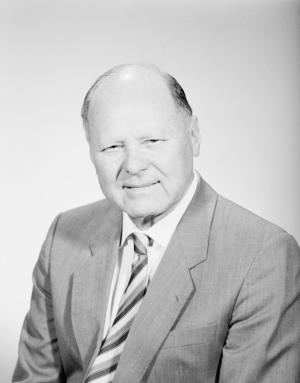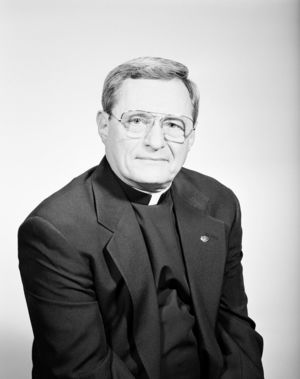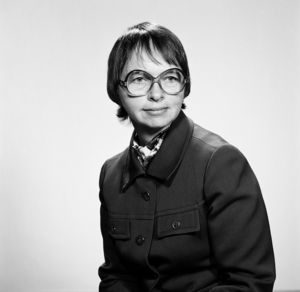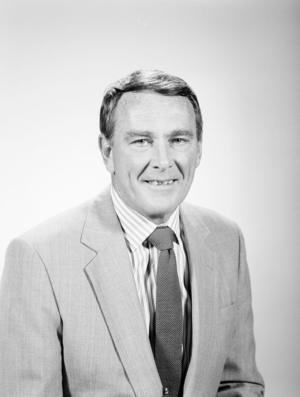
Klaus Lanzinger arrived on campus in 1964 as a visiting assistant professor in the Department of Modern and Classical Languages. He had a landmark first task: creating the University’s inaugural study-abroad program, in Innsbruck, Austria. More than 50 sophomores participated in that initial experience in 1964-65, the success of which led to the creation of other overseas study opportunities for Notre Dame students. The Innsbruck program continued until 2010, and the University today offers academic programs in more than 25 countries.
A native of Wörgl, a small town near the Austrian Alps, Lanzinger left home to do his undergraduate work at Bowdoin College in Maine and later returned to earn his doctorate from the University of Innsbruck. His interests in comparative literature focused on American-European literary relations and writers such as Hawthorne, Melville, Henry James and Thomas Wolfe, culminating in the publication of numerous articles and books in German and English, most notably Jason’s Voyage: The Search for the Old World in American Literature.
Lanzinger officially joined the Notre Dame faculty in 1967 and served three stints as resident director of the Innsbruck program. There he helped students acclimate and learn about his home country, dressing up as Mephistopheles, his favorite character in German literature, for a student-led Halloween celebration and as St. Nick at Christmas.
He was a longtime professor in the Department of German and Russian Languages and Literatures, serving as chair of the department from 1989 to ’96.
In 1979, Lanzinger became a naturalized U.S. citizen. He reflected on the American civil rights movement, politics, visits to his homeland and many other topics in A Transatlantic Diary 1961-1989. “The great historic turning point came toward the end of the 1980s and at the beginning of the 1990s, when the liberation movements in Eastern Europe tore down the Iron Curtain and brought the Cold War to an end,” he wrote.
He died December 5 at age 92.

Rev. Gregory A. Green, CSC, ’58 held many roles during more than a half century of service to Notre Dame and the Holy Cross community. His longest assignment, from 1988 to 2013, was as the University’s staff chaplain. It was a job perfectly suited to Green’s outgoing and social nature. “He would meet you with a smile. He loved people,” says Rev. Nicholas R. Ayo, CSC, ’56, ’62M.A.
As chaplain, Green was one of the most popular attendees at annual staff Christmas parties. For years he attended the wakes or funeral services of anyone he learned of who had worked at the University. He liked to talk with family members and offer comfort, even under sorrowful circumstances.
Born and raised in Chicago, Green knew in elementary school that he wanted to be a priest. He entered the Congregation of Holy Cross in 1953. After receiving his bachelor’s degree from Notre Dame, he earned a master’s degree in theology from Holy Cross College in Washington, D.C. He was studying in Washington during the 1960 presidential campaign that resulted in the election of President John F. Kennedy, whom he met and whose inauguration he attended. Green was ordained in 1962.
At various times he served as rector of Sorin Hall, assistant rector of Breen-Phillips Hall, associate vice president of student affairs and priest-in-residence in Siegfried and Welsh Family halls. He helped with the formation of Holy Cross novices in Bennington, Vermont, and at Moreau Seminary. And he served in positions at St. Joseph and Holy Cross parishes in South Bend, as well as parishes in Detroit and in Watertown, Wisconsin.
He was an enthusiastic fisherman. He traveled to Notre Dame’s Land O’Lakes property in northern Wisconsin whenever he could to catch fish and bask in the beauty of nature. But he never kept the fish. Every catch he made, he tossed back into the lake.
Green died December 15 at Holy Cross House. He was 85.

“I thought I’d spend my life in the little triangle of a parish: living in the convent, teaching in the school, praying in the church, and, if lucky, getting to the dentist twice a year.” That’s how, late in life, Sister Elaine Virginia DesRosiers, O.P., ’66M.S, recalled her embrace of her religious vocation as a teenager in 1948.
Her first 15 years as a Dominican nun went according to plan. Then the Second Vatican Council — and six summers studying biology as a graduate student at Notre Dame — changed everything, transforming the former grade-school teacher into a TV host and audiovisual expert who would lead the University’s trailblazing foray into the world of the computerized classroom.
The former director of educational media at Notre Dame, known as much for her oil paintings, her summer film festivals, her effervescent warmth, her hope and her heart for the poor as for her landmark contributions to campus technology, died December 16, 2020. She was 90.
Having completed her master’s degree, DesRosiers returned to the Boston archdiocese where she grew up, creating The World of Biochemistry, a televised course for high school students broadcast by the Boston Catholic Television Center. The experience led to doctoral studies in educational media and skills that landed her back at Notre Dame in 1976 as head of a small unit that mostly dispersed students and their AV carts through the halls of classroom buildings, but in time would oversee the genesis of a campuswide computing network.
By 1992, DesRosiers and associate director Michael Langthorne had spearheaded plans for DeBartolo Hall, with 84 classrooms wired into a centralized system that enabled professors to use the latest digital and visual media in their courses. As of her retirement in 1997, representatives from more than 650 universities around the world had toured the building.
“Everything concerning people and their betterment — she was into it,” recalled her friend, Gerald Gingras, professor emeritus of Spanish literature at Saint Mary’s College. “She had a total commitment to humanity and saw goodness at every level.”
Returning to her motherhouse in Springfield, Kentucky, DesRosiers’ artistic talents garnered commissions to paint historic and religious buildings — and a Fra Angelico Award from the Dominican Institute for the Arts.
“I recognized that this life of mine has been one big act of gratitude,” she once wrote. “St. Catherine’s teaching, ‘Of myself I am nothing. With God’s gifts I am everything,’ has imbedded in me a deep, deep sense of gratitude to God, the giver of my gifts.”

A native of Philadelphia, Joseph F. O’Brien was a gunnery captain aboard the aircraft carrier USS Midway during World War II. He then attended Notre Dame, graduating in 1949, and worked with local corporations before returning to his alma mater in 1958 as director of personnel (known today as human resources). Much of his career, however — from 1976 to ’93 — was spent in the athletic department, where he was the associate athletic director handling budgets, transportation and ticketing.
As the chief business manager for athletics for almost two decades, he oversaw significant expansion in athletic competition and its financial investment. His leadership and foresight served the department and University well, and his kind and amiable manner carried the institution’s qualities into its transactions. Highly respected among peers in the athletic world, he was also a mentor to many of the student managers whom he supervised. He was instrumental in making travel arrangements for bowl games and other sporting events, and he received numerous awards from the University, professional organizations and local service agencies.
An avid reader with a deep appreciation for poetry, music and military history, he also enjoyed golf, water sports and baseball, especially his beloved Phillies. He was 96 when he died at home January 23, and it was said “his blood ran blue and gold.”